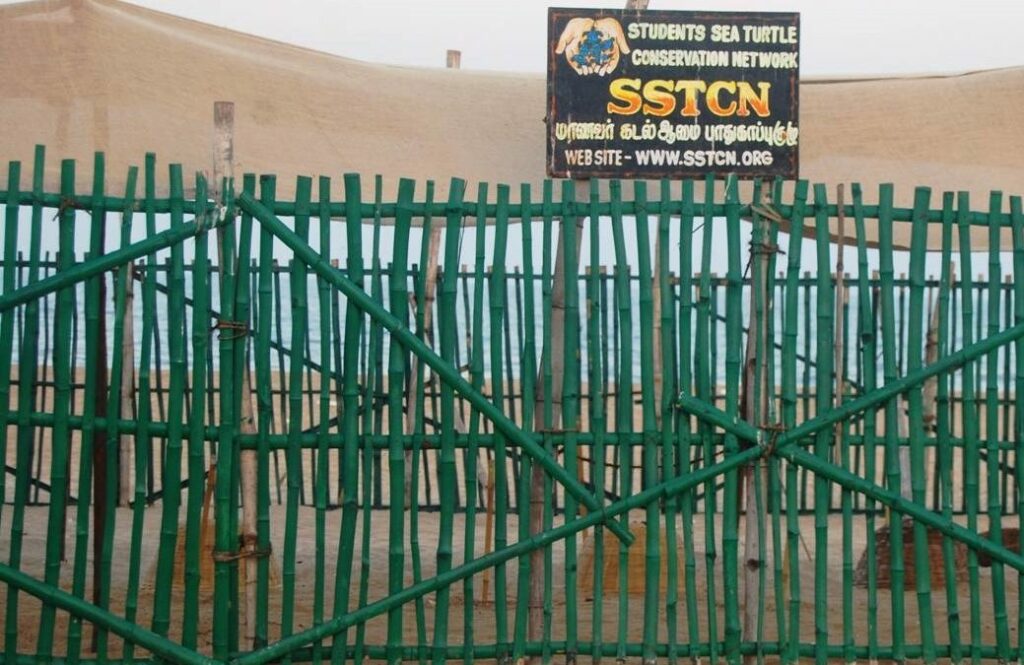
V. Arun
I first learnt of the turtle walks conducted by the Students Sea Turtle Conservation Network (SSTCN) during the first year of its establishment. I had gone with a cousin to his friend’s house and there was Smitha leaving for a turtle walk at 10 pm. I was pleasantly shocked. This was 1990 and in conservative Chennai, here was a girl going off with some boys on an all-night assignment!
A couple of years later, I saw the SSTCN sticker on my friend’s (later to be wife) cupboard. Her uncle, Ananth, a teacher at The School KFI run by the Krishnamurthi Foundation, had been involved in the turtle walks pre-SSTCN days and with WWF, Dipankar Ghosh etc. At the time of seeing this sticker, I was a miserable engineer. I lived a largely pathetic life in Bombay with occasional glimmers of joy, such as forest walks in the Sanjay Gandhi National Park, ping-pong with friends, etc. After 6 years in this industrial hell, I was inspired by Ananth to quit engineering and become a “gardening teacher” in the KFI school.
In all this turmoil of life, turtles had receded into the background. However, on an early morning walk with Ananth, I discovered the hatchery on Neelankarai beach. Unfortunately, it was already April and the season had ended. I rued a missed year, but decided to sign up for the next season, in 1998. I invited Tito [Chandy] to come and give a talk at the KFI assembly, where he was at his charming best, and it turned out to be a huge success. That Saturday, 55 students landed up for the walk. Unfortunately, that also happened to be the worst season in our history. We saw nothing but dead turtles for the first six-weeks and by this time, the number of students had dwindled to 15. However, we grew lucky in the 7th week and saw our first nest. While this helped revive the excitement in the walks, it was short-lived as we had 5 dry walks after that. We ended the season with just 17 nests in all. Still, this marked the beginning of KFI’s long tryst with the turtle walks, and mine too.
My Early Years
In the early years, the walks were very different. Our meeting point was one Pandian’s shop near the Besant Nagar bus stand at 10 pm, after which we would walk through a residential colony and reach the beach at a temple called Arupadai Veedu. Although Elliot’s beach was closer to the Besant Nagar bus stand, we would not enter there to avoid getting caught by the police, not that we were doing anything wrong. It was also believed that there was no nesting there thanks to the extremely bright lights present; occasional walks there never yielded any nests.
On reaching the beach, Sanju (Sanjiv Gopal – who has been in Greenpeace for the past 16 years after 8 years in SSTCN) would do a short briefing. We would set off on the walk around 11.30 pm and depending on whether we found nests, we would finish between 1.30 am and 3 am. Some of us would then proceed to sleep soundly on the beach while the younger ones would play beach cricket till daybreak. After, we would leave and come back to the city by bus. Sleeping on the beach was a huge success and I suspect that some came more for the sleep than the walk itself.
I remember the excitement we would feel every time a nest was spotted. Before cellphones, torch lights were used as signals. If there was a torch light facing the crowd from the scouts, that meant a nest. If the flashlight flickered, then it was a nesting turtle. I remember all of us would run to see the turtle or the nests. This we did for years and years and I only stopped counting my nesting turtles after I crossed 50 turtles.
Among my team of walkers were my students Adhith and Vinod, 11 and 12 years old, so smitten by turtles and turtle walkers. The turtle walkers were of a style then- it was an out and out youth culture. Jeans, bandanas, cigarette dangling from the lips constantly, with an ‘out to save the world’ look about them. I was an oddity among the teenagers – a dhoti clad, bare-foot 28-year-old who had quit engineering and was keen to be seen as a non-conformist to mainstream ways. They were a jolly lot and I was the serious one. In some ways, I brought some respectability and seriousness to the work but I also, in some ways, took the fun out of it.
After Sanju left in 2002, the KFI group pretty much took over the co-ordination. We were a very small crew and were not very inclusive. There was a sense of hierarchy among walkers based on seniority and we were churlish about newcomers. I remember 2003 to 2005 as a bit of the wilderness years. I was personally bogged down by my workload as a teacher in KFI. If this was not enough, I got poked (butted) in the eye by a cow in February 2005. My eye was saved but my eyelid tore, and the season ended for me. Adhith, another young entrant Shravan, Anusha and Nakul managed the rest of the season pretty effectively. Shravan too has stayed on with the walks and has played a critical role in managing the Besant Nagar hatchery over the years. Now, SSTCN draws volunteers from the animal dispensary that he runs. We have also managed to treat the occasional injured turtle in his dispensary.
The Tsunami and the Change Thereafter
On the night of 24th December 2004, our boys were on a recce walk and slept in our usual place. The group just missed the Tsunami as they left 15/20 minutes earlier. The granite wall near which they were sleeping was broken to pieces! There was a sense of fear being on the beach after that.
Arising from this, we took a major decision which changed our work a lot. We decided to reverse the direction of the walk from Neelankarai to Besant Nagar and go home after the walks. No more sleeping and being caught unawares by lurking tsunamis.
Thanks to this decision, we began to walk till Elliot’s beach and lo and behold, it was full of nests!
Then the question arose as to whether we should walk the last stretch of the beach before the Adyar river which was bordered by the walls of the Theosophical society and, therefore, dark and uninhabited. Many felt that the conditions there were ideal and that we should just leave it be. However, we had to set up our hatchery there as it was the only safe place. We also came to know that the nests there barely survived because of a huge population of feral dogs and a few jackals. While we were happy to let the jackals multiply using the turtle eggs, we were not willing to be so empathetic towards the feral dogs and we still keep racing to reach the nests before they do. Every year since, we have been doing a round of ABC (animal birth control) in Urur Kuppam to control the dog population.
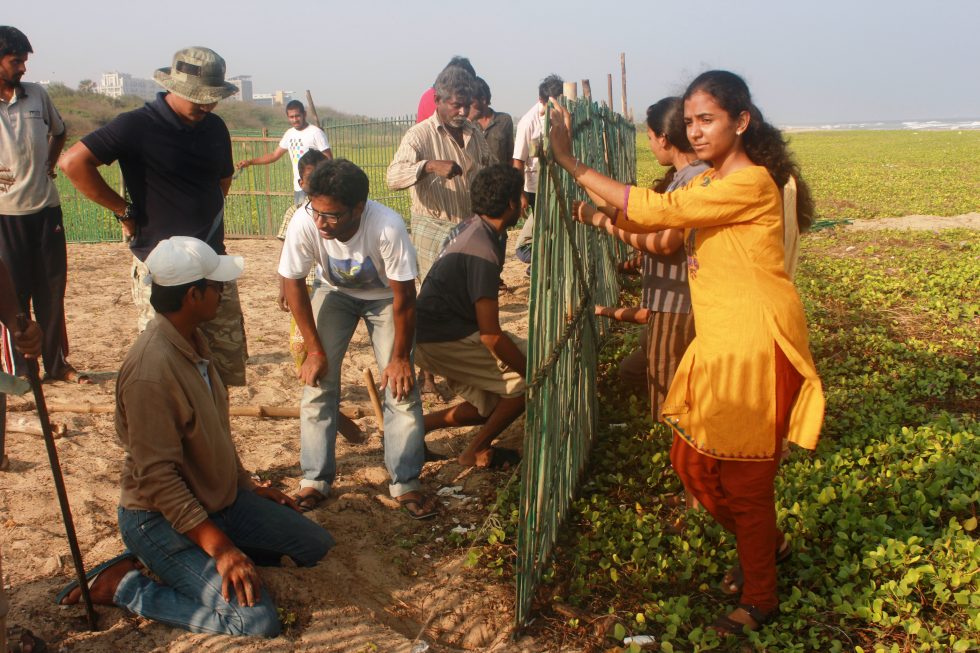
Following the tsunami, 2005 turned out to be a strange season. We were the only ones on the beaches. No fisherfolk were there and no general public either. The beaches were deserted. All the boats had been washed away too. The one good thing was that there were no dead turtles either. But it sure felt lonely on the walks. We missed having the fisherfolk on the beach and didn’t enjoy walking past desolate villages.
Enter Akila
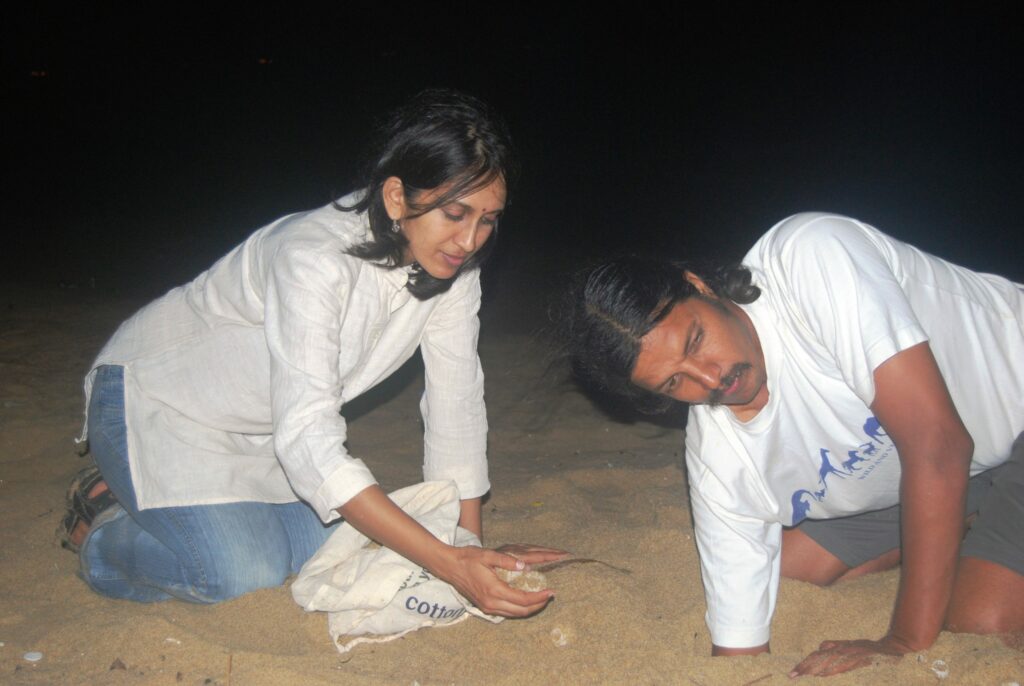
In 2006, Akila entered the scene, or should I say re-entered the scene? She had walked in the early 1980s while still in college and then, after a hiatus away from environmental work with a violin and a life in the Middle-East, she came back with tremendous energy and happiness to be a part of the turtle walks again.
She broke the hegemony of the KFI group and under her more inclusive presence, the group grew exponentially. Perhaps, it also coincided with the IT boom as we suddenly had a number of bored IT workers who couldn’t sleep in the night on weekends as a result of doing night shifts through the week. Whatever the reason, our numbers suddenly swelled. We also had a number of students from engineering colleges; notable among them were Nishanth, Ravi and their gang. Starting modestly, they began to provide the bulk of the work force over the next decade.
Girls and Turtle Walks
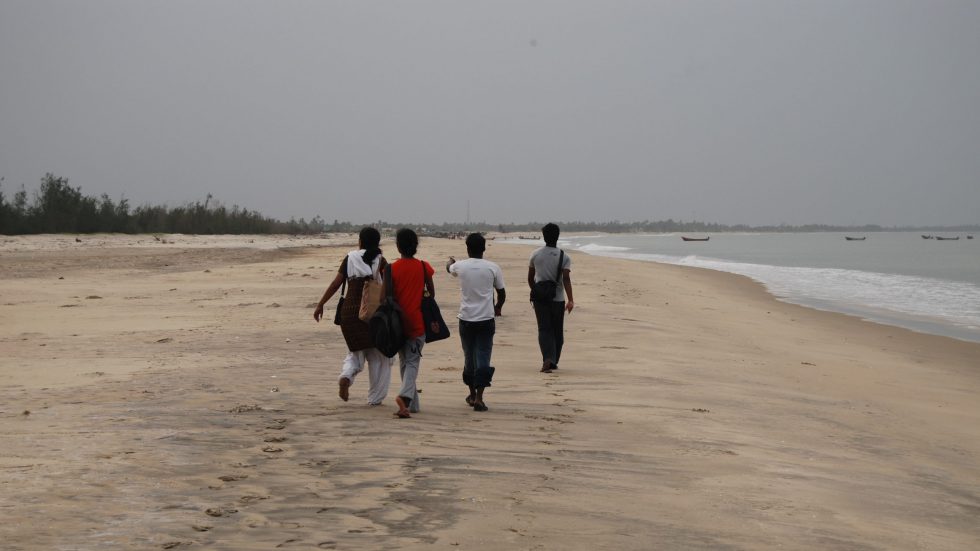
I believe there was a time in the early 1990s when the group was run by a team consisting of several girls and some guys. However, during my time, we haven’t been able to allow girls to patrol weekday nights due to the unsafe conditions. This has been really unfortunate as we are losing out on a huge section of genuinely interested walkers; we always seem to have more girls volunteering than boys. On the public walks too, it sometimes appears to be the wives, daughters and sisters who are dragging not so enthusiastic husbands, fathers and brothers along. We really wish that our girls could walk the beaches safely. They could make a huge difference.
Currently, some girls are part of the scouts’ group on weekend walks and take up a large share of the hatchery work as well.
Suddenly Not an Informal Group Anymore
In 2009, I moved to Thiruvannamalai to be a part of an afforestation effort on the Arunachala hill and also to start an alternative school. While registering the trust for the same, the Director of Trusts insisted that we register a trust for the turtles too. So, after 20 years of functioning informally, we registered SSTCN as a trust with Akila, Sanju, Adhith and me as trustees. SSTCN had been registered as a society by Kartik Shanker and Tito Chandy in 1989, but it was never followed up and the papers were lost, and SSTCN was again registered as a trust in 2012.
With us now being a trust, and the possibility of raising funds and paying people, we decided to expand the area under our cover to include Marina. The first year that we paid people, we realized what a different game that was and it was something we were really not ready for. However, due to these efforts, we got to know that there was indeed nesting in the Marina beach. We found 30 nests in 2009.
Marina
In 2011, it was decided that we would monitor the Marina stretch with our own volunteers. This meant that we would need double the number of volunteers every night. With the increase in our volunteers over the years, we felt confident that we would be able to handle the new stretch too.
From 30 nests we jumped to 80 the next year and 150 the year after. Now, Marina is our biggest nesting ground.
With the kind of commercial activity that goes on there, the crowds that mill about, the lights, and other disturbances, no one would believe that there is nesting there, let alone high nesting.
Working in Marina was also a new experience for us. On the Besant Nagar stretch, turtle walks have been going on since the 1970s. Even the older people in the fishing hamlets have grown up seeing this activity happen from their childhood. Turtle walkers and turtle walking is a part of the cultural history of the coast. However, we were unheard of in the Marina part of the city.
We were encountering poachers, facing threats, and meeting resentful fisherfolk while at the same time receiving support from conservation-minded fishers. The more friendly fishermen were going out of their way to be helpful to our members, marking nests and protecting them, removing them and keeping it carefully, handing it to us, etc.
After Marina was added, we were covering 13.5 km of beach stretch. However, Marina is a shorter stretch and has lent itself to different strategies over the years. Walking Marina is a very different ball game compared to the long overnight stretch of the Besant Nagar beach.
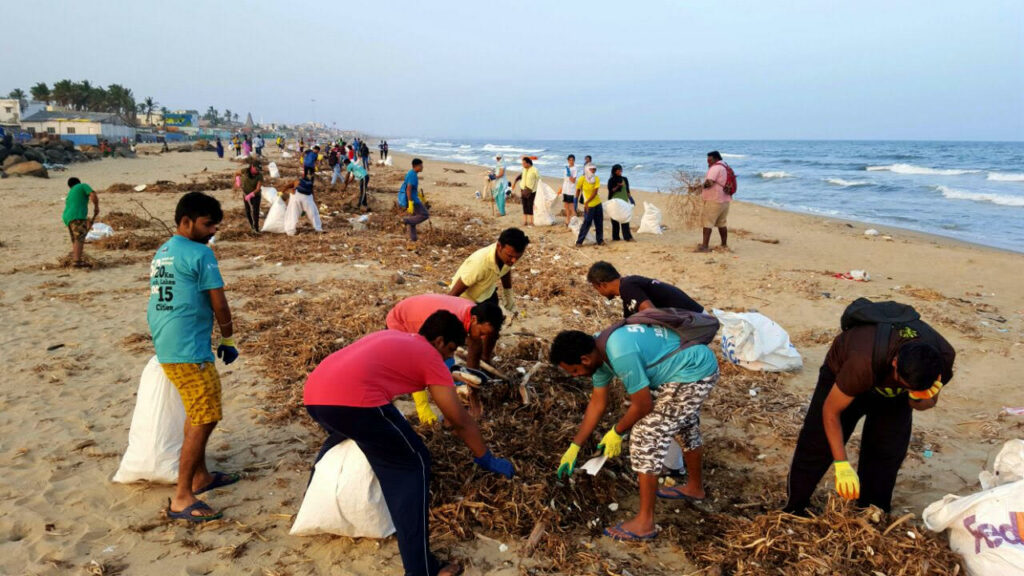
Chennai’s Own Arribada
Every season, Chennai has its own version of the arribada. On most nights of the regular season whenever we encounter more than 3 nests, we feel it is a big haul. However, around the time Odisha has its arribada, Chennai too experiences a surge in nesting. Over two to three nights, we may end up having between 15 to 40 nests. The largest number of nests we encountered on a single night was 23 over 13.5 km. Needless to say, our normal patrolling strength of 4 people can’t handle such a number. Over the years we have become quite accustomed to this surge and when such nights happen, all the volunteers are on call. Those available, pitch in to carry and relocate the nests. Even then, the night is a long one with the last nest being relocated around 8.30 or 9 am.
In earlier years, when we were caught off guard, we managed the situation with a price – the large nesting nights also yielded the least number of hatchlings. I would put this down to human error and delays in relocating. With better coordination now, the success rate has gone up considerably.
Those nights are very draining but also very rewarding, being unforgettable experiences. Though there were many such nights, one in particular stands out.
We had called off the walk due to a persistent rain and I had gone to bed. I was awoken at 11 pm by a man who had gone to Marina and found a nesting turtle. As he had been on a public walk earlier, he had the resourcefulness to remove the eggs and bring it to the KFI school compound where I was residing. These were pre-cell phone days. Now, however, people need only make a phone call and we send a member of our team to help. My colleague, Vinayan, a fellow turtle walker and I put the eggs in a cardboard carton and took it to the hatchery.
After relocating the eggs, we decided to walk just a little bit to see if we could find anymore. Within 50-feet we found one more nest, and then another 100-feet away. We relocated these two and walked some more. Two more nests within two kilometres. We put them in the carton with Vinayan’s T-shirt in the middle to separate the two clutches. Then, my T-shirt became the next bag. We kept walking and finding nests, and soon had no more places to store the eggs. We hid the remaining eggs in a beach-side kiosk and went looking for containers. During this time, I realized that we were near the house of one of my students. I went and knocked on her door around 3 am and the student’s mother was startled to see a bleary-eyed, bare-bodied fellow, who sort of resembled her daughter’s teacher asking her for bags. It didn’t seem like she could comprehend anything about the situation, but she quickly gave me some plastic bags. I then asked her for the keys to her scooter. She looked even more startled but was keen to get rid of me and so gave me that too.
As we rode to the hatchery, two bare-bodied, bearded, drunk looking men at 5 am with hundreds of eggs in our possession, our only wish was that no policeman should catch us. We neither had any money nor any license or ID with us. Thankfully, no one caught us, and when we headed back to school at 8 am, we were beaming with happiness, having saved 9 nests in total.
My Last 10 Years
After moving to Thiruvannamalai, travelling 200 km every weekend to reach Chennai seemed a bit crazy. On Friday evenings it could take up to 9 hours at times. I would leave around 3 pm then reach around 10 pm, grab a quick dinner, and rush to the walks. I would then stay awake all night interacting with two groups of 50/60 people each night and head back to Thiruvannamalai on Sunday afternoon.
Earlier while in the KFI, after a Friday night’s walk, I would often go back to staff meetings on Saturdays followed by film clubs in the afternoons. That used to be my life in KFI every fortnight. I am much freer now on the weekends and I find myself bringing more energy to the walks and engagements over the last 10 years compared to the first 12 years. In other words, at 51, I find myself more energetic and raring to go than at 31. Of course, it helps that we have Akila, who despite being older than me, inspires us with her endless energy and enthusiasm not to mention complete dedication.
Turtles have become such an integral part of my life, with the turtle season marking the beginning of the year and embracing nearly half of it. I have met and engaged with tens of thousands of people and been a part of the release of nearly two hundred thousand hatchlings. I wonder what my life would have been like had the turtles not entered my world.
Turtles have surely brought much to my life, and I hope that I too have brought something to them.